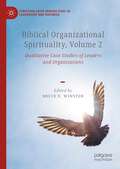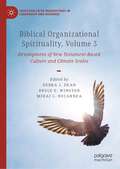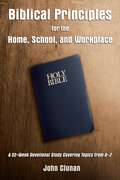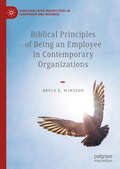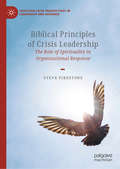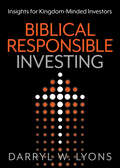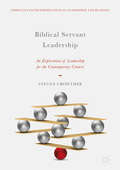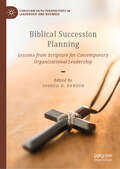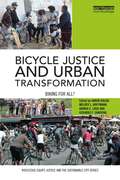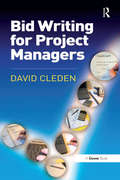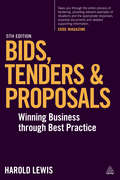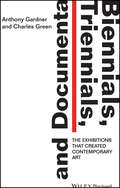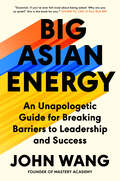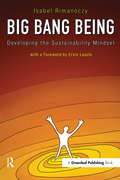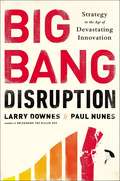- Table View
- List View
Biblical Organizational Spirituality, Volume 2: Qualitative Case Studies of Leaders and Organizations (Christian Faith Perspectives in Leadership and Business)
by Bruce E. WinstonThis book expands on the New Testament leadership principles introduced in Volume 1 and draws connections to the contemporary organizational leadership literature. By applying these principles to analyze modern organizations and leaders, it aims to uncover how they are manifested within an organization and their impact on both the organization and individual employees. Through interviews with leaders and coding of the transcripts, the chapter authors develop scale-development items to measure the concept of organizational spirituality within organizations. This volume offers theoretical framing and practical applications for scholars and practitioners in the field of organizational leadership, particularly those interested in the Christian perspective.
Biblical Organizational Spirituality, Volume 3: Development of New Testament-Based Culture and Climate Scales (Christian Faith Perspectives in Leadership and Business)
by Bruce E. Winston Mihai C. Bocarnea Debra J. DeanThis volume introduces scales for measuring organizational spirituality culture and climate. Based on interviews with employees, the chapters present empirical studies confirming the scales' validity and reliability, rooted in principles aligned with Biblical concepts of love. The authors conduct concurrent and discriminant validity studies, comparing these scales with measures of servant leadership, person-supervisor fit, altruistic love, inner life, vision, person-organization fit, affective commitment, continuance commitment, normative commitment, and work-state anxiety in contemporary organizations. This book offers researchers with two reliable instruments to assess New Testament-based organizational spirituality culture and climate, contributing new insights to the field of organizational spirituality literature and aiding in diagnosing organizational spirituality-related issues.
Biblical Organizational Spirituality: New Testament Foundations for Leaders and Organizations (Christian Faith Perspectives in Leadership and Business)
by Joshua D. HensonThis book offers an in-depth exploration of various New Testament passages with the purpose of identifying lessons, values, and behaviors that can contribute to an understanding of organizational spirituality from a Christian worldview. Covering contemporary concepts such as women in leadership, cross-cultural leadership, transparency, and authenticity, each chapter examines an organizational leadership topic through the lens of specific New Testament principles. This volume with a fresh perspective provides theoretical and practical applications for scholars and practitioners in the field of organizational leadership.
Biblical Principles for Resilience in Leadership: Theory and Cases (Christian Faith Perspectives in Leadership and Business)
by Carlo A. SerranoThrough sound exegetical methodologies and the current research on organizational leadership, this book uses biblical examples to explore the realities of leadership fatigue. Addressing topics such as stress, crisis, and pressures in leadership, this book offers biblical principles in each chapter that practically connect theory with application. The chapters explore topics such as leadership transitions, the value of followership, crisis management, and leadership in large organizations. Using contemporary organizational leadership research, grounded in biblical theology, this book will appeal to those studying leadership, organizational behavior, and human resource management.
Biblical Principles for the Home, School, and Workplace: A 52-Week Devotional Study Covering Topics from A – Z
by John ClunanMost of us spend the majority of our time on this earth at home, school, and the workplace. If you’re in school, you may also be spending time on any number of extracurricular activities, and if you’re in the workplace, you may also be spending time on additional work-related activities such as traveling to meet with customers, attend conferences, and participate in offsite training and team-building activities, just to name a few. In other words, we’re all busy, and in some cases we feel like you’re too busy. So home should be our respite from the demands of school and the workplace, right? It should be a place of comfort and relaxation. But that’s not necessarily the case because we’re also busy managing numerous responsibilities at home, as well as caring for our most important relationships. <P><P> OK, so other than stating the obvious, what point am I trying to make? The point is this: we need help navigating through life. We need guidance and wisdom to manage our responsibilities, and in particular our relationships. The question is, where are we going to turn for answers? While there are many options, there’s only one best option, and that’s God’s Word. I want to point you to God’s Word to help you address the myriad concerns and issues that are common to everyone. These concerns and issues are relevant at home, they are relevant at school, and they are relevant in the workplace. While acknowledging there are many wonderful daily devotional books that are readily available, this devotional book is different. Rather than presenting a different devotional topic every day, I’ve intentionally chosen to address one important topic each week. <P><P> I’ve done this because I want you to have the opportunity during the week to reflect upon and apply the Biblical concepts of God’s Word. This will allow God’s Word to become more fully implanted into your heart and mind, allowing you to grow and become more equipped to handle the challenges of life in a manner that’s pleasing to God. I’ve even added a journal section following each devotional that will allow you, if you choose to do so, to express your thoughts and experiences for the week as they pertain to the topic. <P><P> There’s even enough space for you to add to your journal as you further reflect upon the various topics during the course of the year or subsequent years. It’s my heart’s desire that you, your family, your classmates, your coworkers, your customers, your neighbors, and even strangers will be richly blessed because you chose to read this devotional book. In particular, I pray that as you spend time reflecting upon and applying the wonderful principles from God’s Holy Word, you’ll grow in your knowledge and your love for Him and His Son Jesus Christ.
Biblical Principles of Being an Employee in Contemporary Organizations (Christian Faith Perspectives in Leadership and Business)
by Bruce E. WinstonThis book focuses on how employees should work and follow in contemporary organizations. It begins with the call from Col 3:22-24 for employees to treat work as worship to God and to conduct their work to the best of their ability (Prov 22:29). It then explains how employees should help each other but not to the point of self-defeat (Galatians 6). Employees are then cautioned for the need to be true followers but to know the extent to which being a follower might call them to be committed to both the organization and the leader/manager. This is the concept of Akoloutheo. The rewards of being diligent and faithful employees are conveyed through an examination of the Parable of the Talents. The book concludes with an admonishment to everyone to prepare versus plan for one’s personal life. Managers plan for projects but should prepare for what God asks each of us to do and then to accept the opportunities that God presents to us.
Biblical Principles of Crisis Leadership: The Role of Spirituality in Organizational Response (Christian Faith Perspectives in Leadership and Business)
by Steve FirestoneThis book explores how spirituality can improve an organization’s ability to respond to a crisis. It presents biblical examples of leading during a crisis to show how faith can be relied upon to lead during crisis situations. Further, it presents examples of leaders using their faith during trying times. In recent years, organizations have begun to prepare for crises, but scholarly research has not kept up with their efforts. Exploring topics such as communication, servant leadership, and resilience, this work stakes new ground in leadership theory and will foster future research into the role of spirituality during organizational crisis.
Biblical Principles of Hiring and Developing Employees (Christian Faith Perspectives In Leadership And Business Ser.)
by Bruce E. WinstonThis book begins with the scriptural support for person-organization fit and person-job fit. The book then examines scriptural support for the four-Cs of people’s work-fit: Calling, Competence, Confidence, and Character. Finally, the book uses Acts 6:1-7 as a basis for identifying the type of people one should look to hire. The book covers two development concepts: Nomos, about ruling in an organization, and progressive responsibility from Luke 16:10. The chapters present the concepts from a scriptural base and include composite case examples that relate to contemporary organizations.
Biblical Responsible Investing: Insights for Kingdom-Minded Investors
by Darryl W. LyonsA large shift in financial resources is currently underway. Learn how to position yourself to make effective money moves that will have a lasting impact on America’s future.Biblical Responsible Investing is for Christians who want to become more intentional, resourceful, and collaborative with their money, as well as how to use the financial markets to increase their return. Additionally, it explores various ways to become involved in the latest trends in the money market.Originally designed as a manuscript for Wall Street executives to gain insight into Christian approaches to money decisions, Biblical Responsible Investing documents eleven principles that, when understood, will bring a fresh and essential perspective to the table. The revised manuscript is tailored to the needs of everyday people, providing practical direction on how the trends identified can be applicable to their personal financial decisions. Inside the shadowboxes found at the end of each chapter are the tools for Christians to confidently make their financial decisions with a focus on helping their own community and faith.
Biblical Servant Leadership: An Exploration of Leadership for the Contemporary Context (Christian Faith Perspectives in Leadership and Business)
by Steven CrowtherThis book explores the concepts from Scripture for Servant leadership and compare these findings with contemporary models of servant leadership. It is an examination of Christian leadership for the contemporary world in its global and increasing secular context. Leadership studies typically view leadership externally from the results. This is a good beginning but leadership needs to also view the inside of leadership in the person of the leader. Scripture is uniquely qualified in this area since its first concern is the person who leads not just in leadership behaviors. The author uses examples from both the Old and New Testament to establish a new shepherd model of leadership that moves beyond the servant mode to the mode of caring direction. This model will provide scholars and researchers as well as leaders themselves with a way of leading that overcomes negative forms of leadership which lead to failure.
Biblical Succession Planning: Lessons from Scripture for Contemporary Organizational Leadership (Christian Faith Perspectives in Leadership and Business)
by Joshua D. HensonThis book focuses on the contemporary applications of effective and ineffective leader succession narratives for contemporary organizational leadership. From Moses and Joshua to Paul and Timothy, the Old and New Testaments are replete with narratives described the leader transitions of prophets, judges, kings, apostles, and pastors. Leadership succession is a complex process in that each situation is contextually unique. This book explores 10 narratives in the Bible that demonstrate the contextual complexities of leader succession and how leaders navigated it, for the good and bad. Each chapter focuses on a different example of leader succession: six Old Testament narratives, three New Testament narratives, and one chapter that takes a more holistic Scriptural approach. The chapters provide practical organizational leadership principles that can be applied to contemporary succession planning. Overall, this work contributes to an emerging field of succession planning and informs organizational leaders how to lead from a Biblical perspective.
Biblical Theology for Ethical Leadership: Leaders From Beginning To End (Christian Faith Perspectives In Leadership And Business Ser.)
by Aaron PerryThis book argues that ethical leadership without a theological foundation is lacking a firm foundation. It begins with a critical assessment of ethical leadership as a leadership theory, showing how ethics and theology became separated, creating the space for ethical leadership outside of theology. Nevertheless, the author argues that ethical leadership without a biblical basis is weak, though one need not be religious to embrace the leadership principles of biblical theology. Unfolding Christology, anthropology, eschatology, and contextualized leadership as four key aspects of biblical theology for ethical leadership, this book will appeal to those studying leadership, business, innovation, and entrepreneurship.
Bicycle Justice and Urban Transformation: Biking for all? (Routledge Equity, Justice and the Sustainable City series)
by Aaron Golub Melody L. Hoffmann Adonia E. Lugo Gerardo F. SandovalAs bicycle commuting grows in the United States, the profile of the white, middle-class cyclist has emerged. This stereotype evolves just as investments in cycling play an increasingly important role in neighborhood transformations. However, despite stereotypes, the cycling public is actually quite diverse, with the greatest share falling into the lowest income categories. Bicycle Justice and Urban Transformation demonstrates that for those with privilege, bicycling can be liberatory, a lifestyle choice, whereas for those surviving at the margins, cycling is not a choice, but an often oppressive necessity. Ignoring these "invisible" cyclists skews bicycle improvements towards those with choices. This book argues that it is vital to contextualize bicycling within a broader social justice framework if investments are to serve all street users equitably. "Bicycle justice" is an inclusionary social movement based on furthering material equity and the recognition that qualitative differences matter. This book illustrates equitable bicycle advocacy, policy and planning. In synthesizing the projects of critical cultural studies, transportation justice and planning, the book reveals the relevance of social justice to public and community-driven investments in cycling. This book will interest professionals, advocates, academics and students in the fields of transportation planning, urban planning, community development, urban geography, sociology and policy.
Bid Writing for Project Managers
by David CledenAt what stage in the process do commercial projects go wrong? Some of the worst problems (unrealistic objectives, faulty assumptions, and poorly understood constraints) are 'programmed in' at conception when the bid is written, long before the project manager is brought on board. If the bid is misconceived, no amount of clever project management is going to recover the situation. Involving the designated project manager at the bidding stage is becoming the norm in many commercial organizations. Some make the project manager the bid manager so they can direct all aspects of the project's conception. Getting the bid right is the essence of planning for project success, and is the main theme of this book. However, many project managers are unfamiliar with the pitfalls of competitive bidding and don't know how to balance a compelling sales message against a realistic delivery plan. Bid Writing for Project Managers will guide prospective project managers through the bid-writing lifecycle, providing comprehensive guidelines and numerous tips on how to craft a winning bid and how to set the project up with the best possible chance of success.
Bidding for Antamina
by Peter Tufano Alberto MoelIn June 1996, executives of the multinational mining company RTZ-CRA contemplate bidding to acquire the Antamina copper and zinc mine in Peru. The Antamina project is being offered for sale by auction as part of the privatization of Peru's state mining company. RTZ-CRA has to determine what the mine is worth and decide whether and how it should bid in the upcoming auction. The bidding rules put in place by the Peruvian government dictate that each company's bid contain two components: an up-front cash amount and an amount the bidder will invest to develop the property if development is warranted after further exploration is completed.
Bidding for Development: How the Olympic Bid Process Can Accelerate Transportation Development (Sports Economics, Management and Policy #9)
by Ngiste Abebe Mary Trina Bolton Maggie Pavelka Morgan PierstorffIn 2012, over four billion people tuned in to watch the London Summer Olympics. As the single largest mega-event in the world, the Olympics has the power to captivate the global imagination. Long before athletes vie for a gold medal, however, competition between cities eager to host the Games kicks off with a rigorous bid process. The lengthy and expensive endeavor to host the Olympics is as high-stakes as any sporting event. Rather than encouraging cities to refrain from bidding, Bidding for Development takes a policy approach that challenges stakeholders to bid responsibly and strategically in pursuit of concrete outcomes. Every bid city has the potential to accelerate long-term transportation development through a strategic and robust planning process. This book concentrates on the phenomenon of repeat Olympic bids and the opportunities that may come from bidding, particularly for those cities that never win the Games. In this context, Bidding for Development explores the intersection between transportation infrastructure development, the Olympic bid process, and the resulting legacies experienced by bid losers. The findings address the central question: how can participating in the Olympic bid process accelerate transportation development regardless of the bid result? In response, this book presents a Bid Framework outlining how and when cities may use the bid to unite resources, align transportation priorities, and empower leaders to achieve urban development objectives in preparation for the Olympic bid. The Bid Framework is then applied to two case studies, Manchester and Istanbul, to examine each bid loser's effectiveness in using the bid process to catalyze transportation development. Concurrently, the book takes into consideration how the International Olympic Committee's evolving bid regulations and requirements relate to urban development and positive social legacy. Bidding for Development delivers actionable recommendations for all Olympic stakeholders to improve the value of the bid process and transportation benefits beyond the Games.
Bidirectional Transformations: International Summer School, Oxford, Uk, July 25-29, 2016, Tutorial Lectures (Lecture Notes in Computer Science #9715)
by Perdita Stevens Jeremy GibbonsBidirectional transformations (BX) are means of maintaining consistency between multiple information sources: when one source is edited, the others may need updating to restore consistency. BX have applications in databases, user interface design, model-driven development, and many other domains. This volume represents the lecture notes from the Summer School on Bidirectional Transformations, held in Oxford, UK, in July 2016. The school was one of the final activities on the project "A Theory of Least Change for Bidirectional Transformations", running at the University of Oxford and the University of Edinburgh from 2013 to 2017 and funded by the UK Engineering and Physical Sciences Research Council. The five chapters included in this volume are a record of most of the material presented at the summer school. After a comprehensive introduction to bidirectional transformations, they deal with triple graph grammars, modular edit lenses, putback-based bidirectional programming, and engineering of bidirectional transformations.
Bids, Tenders and Proposals
by Harold LewisBids Tenders and Proposals is a practical guide to winning contracts and funding through competitive bids, proposals and tenders. Written in a clear, accessible style using examples and checklists from real-life winning bids and tenders, this book explains how to create bids that are outstanding in both technical quality and value for money. This fully updated fifth edition extends the scope and content of the book, making it suitable for established contractors as well as anyone who needs to put together a bid for business or funding. This timely new edition covers the 2015 EU regulations for proposals, bids and tenders, including the latest regulatory changes to ensure that the reader has the most current guidelines. It also includes new content on bidding for contract opportunities in international markets and information resources to support bids. Bids, Tenders and Proposals provides fully up-to-date best practice and is essential reading for anyone involved in tendering for new business.
Biennials, Triennials, and Documenta: The Exhibitions that Created Contemporary Art
by Charles Green Anthony GardnerThis innovative new history examines in-depth how the growing popularity of large-scale international survey exhibitions, or 'biennials', has influenced global contemporary art since the 1950s. Provides a comprehensive global history of biennialization from the rise of the European star-curator in the 1970s to the emergence of mega-exhibitions in Asia in the 1990s Introduces a global array of case studies to illustrate the trajectory of biennials and their growing influence on artistic expression, from the Biennale de la Méditerranée in Alexandria, Egypt in 1955, the second Havana Biennial of 1986, New York's Whitney Biennial in 1993, and the 2002 Documenta11 in Kassel, to the Gwangju Biennale of 2014 Explores the evolving curatorial approaches to biennials, including analysis of the roles of sponsors, philanthropists and biennial directors and their re-shaping of the contemporary art scene Uses the history of biennials as a means of illustrating and inciting further discussions of globalization in contemporary art
Bifurcation Theory for Hexagonal Agglomeration in Economic Geography
by Kiyohiro Ikeda Kazuo MurotaThis book contributes to an understanding of how bifurcation theory adapts to the analysis of economic geography. It is easily accessible not only to mathematicians and economists, but also to upper-level undergraduate and graduate students who are interested in nonlinear mathematics. The self-organization of hexagonal agglomeration patterns of industrial regions was first predicted by the central place theory in economic geography based on investigations of southern Germany. The emergence of hexagonal agglomeration in economic geography models was envisaged by Krugman. In this book, after a brief introduction of central place theory and new economic geography, the missing link between them is discovered by elucidating the mechanism of the evolution of bifurcating hexagonal patterns. Pattern formation by such bifurcation is a well-studied topic in nonlinear mathematics, and group-theoretic bifurcation analysis is a well-developed theoretical tool. A finite hexagonal lattice is used to express uniformly distributed places, and the symmetry of this lattice is expressed by a finite group. Several mathematical methodologies indispensable for tackling the present problem are gathered in a self-contained manner. The existence of hexagonal distributions is verified by group-theoretic bifurcation analysis, first by applying the so-called equivariant branching lemma and next by solving the bifurcation equation. This book offers a complete guide for the application of group-theoretic bifurcation analysis to economic agglomeration on the hexagonal lattice.
Big Asian Energy: An Unapologetic Guide for Breaking Barriers to Leadership and Success
by John WangIn his groundbreaking leadership book, John Wang, a top empowerment coach to Asian American professionals across Fortune 500 companies, offers research-backed guidance for Asian Americans to embody their most confident selves in business, relationships, and their everyday lives. Asians today are smashing box office records, winning Oscars, dominating global music charts, and reaching the office of vice president of the United States. Yet studies show Asian American professionals are still less likely to be promoted to leadership roles, and they struggle with self-confidence and self-criticism more than any other racial group. With Asian visibility now higher than it has been in decades, how can the new generation of Asian Americans finally step into our power? In his book, John Wang offers his unique framework for empowerment. He is an experienced leadership coach to the Asian American community who can help readers in every area of their lives. He has supported hundreds of clients from Google, American Express, Goldman Sachs, and other global companies, and his coaching videos have reached more than 25 million views on TikTok. Through proven exercises and successful client stories, he shows how cultural values like collectivism might make some avoid claiming credit in group projects, or how deference to elders creates communication issues. He sees Achievers and Fixers burning out, and Chameleons or Invisible Ones assimilating themselves into imposter syndrome. Instead of urging assimilation, Wang will show Asian Americans how to advocate for themselves on their own terms, through culturally informed guidance. Through his deeply relatable stories and his witty and disarming voice, John Wang offers a bold, moving, insightful, and practical guide. Big Asian Energy aims to teach readers to identify their authentic strengths and values, and to finally break through societal barriers.
Big Bang Being: Developing the Sustainability Mindset
by Ervin Laszlo Isabel RimanoczyWhen asked for the definition of mental health and fulfilment, Sigmund Freud had two words: lieben und arbeiten, love and work. In this book we will find how 16 business leaders brought together their compassion, their caring for others and the world, with their work.True, only on rare occasions are we able to meet the person behind initiatives that made a positive impact on the world, even less have an in-depth view into their feelings, concerns, hesitations, doubts and most intimate thoughts. What is seen publicly is the initiative, the impact on the bottom line and the community, or sometimes on the environment. Yet it is their _personal_ stories that can be most inspirational, since they draw our attention to the fact that amazing achievements start in simple ways, with just the thinking of one individual. And when we find out that the "exemplary individuals" have many very "human" aspects that we identify with and find in ourselves, it brings us closer; and, particularly, it may even trigger in us the question: If she could do it... I wonder what could _I_ do?The interviews, however, were only the beginning of the journey. The lessons of the interviews made it possible to identify how we can all develop a sustainability mindset: in other words, the thinking and the being that can take us from breakdown to breakthrough on this planet. Each one of us can play a part in leading the change; in fact, we are already playing a part – we are just not necessarily aware if that is the part we would like to play, or aware that we choose the change we are contributing to unfold.Part I presents the 16 leaders, including a summary of their story and their initiatives. Part II goes a little deeper, as you will find two dimensions that were not obvious but which underlie the way these business leaders championed the initiatives: the Thinking and the Being. Part III explores why sustainability change is so slow, and addresses the "elephant in the room": the values and beliefs that anchor our Western Weltanschauung, or worldview. Part IV addresses the alternatives that we have to convert the unsustainable values into opportunities that will permit humanity to thrive and to break through the obstructions that prevent us from stasis. Finally, Part V takes us beyond the tipping point, and presents us with an opportunity to evolve as humans developing a new way of thinking and being on this planet. This transformation is so radical and significant, that the author calls it the Big Bang Being.
Big Bang Disruption
by Larry Downes Paul NunesIt used to take years or even decades for disruptive innovations to dethrone dominant products and services. But now any business can be devastated virtually overnight by something better and cheaper. How can executives protect themselves and harness the power of Big Bang Disruption? Just a few years ago, drivers happily spent more than $200 for a GPS unit. But as smartphones exploded in popularity, free navigation apps exceeded the performance of stand-alone devices. Eighteen months after the debut of the navigation apps, leading GPS manufacturers had lost 85 percent of their market value. Consumer electronics and computer makers have long struggled in a world of exponential technology improvements and short product life spans. But until recently, hotels, taxi services, doctors, and energy companies had little to fear from the information revolution. Those days are gone forever. Software-based products are replacing physical goods. And every service provider must compete with cloud-based tools that offer customers a better way to interact. Today, start-ups with minimal experience and no capital can unravel your strategy before you even begin to grasp what's happening. Never mind the "innovator's dilemma"--this is the innovator's disaster. And it's happening in nearly every industry. Worse, Big Bang Disruptors may not even see you as competition. They don't share your approach to customer service, and they're not sizing up your product line to offer better prices. You may simply be collateral damage in their efforts to win completely different markets. The good news is that any business can master the strategy of the start-ups. Larry Downes and Paul Nunes analyze the origins, economics, and anatomy of Big Bang Disruption. They identify four key stages of the new innovation life cycle, helping you spot potential disruptors in time. And they offer twelve rules for defending your markets, launching disruptors of your own, and getting out while there's still time. Based on extensive research by the Accenture Institute for High Performance and in-depth interviews with entrepreneurs, investors, and executives from more than thirty industries, Big Bang Disruption will arm you with strategies and insights to thrive in this brave new world.
Big Bazaar
by Ananth Raman Laura WinigDescribes a high-growth Indian retailer, Pantaloon Retail (India) Ltd., and two of the company's formats--Big Bazaar and Food Bazaar. Challenges students to debate the company's concept, its strategic decision on how quickly it would like to grow, and some key decisions on its supply chain. At the time of the case (2006), small "mom-and-pop" stores still dominated Indian retailing, but that was changing rapidly because of the entry of "organized" retailers such as Pantaloon. Pantaloon's management faced some exciting opportunities as well as some potential competition from global retailers that were planning to enter the Indian market and large Indian business houses that were planning to establish retailing businesses.
